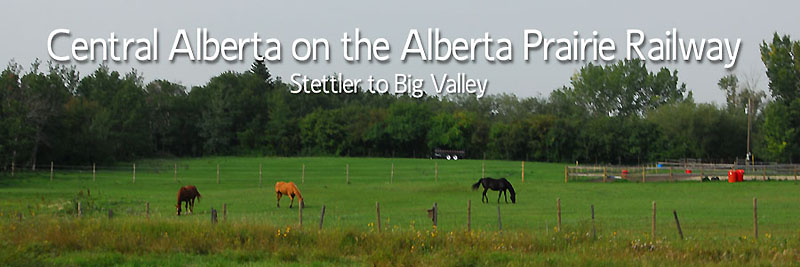
RETURN TO TREVORMCTAVISH.COM
Stettler and Big Valley, AB, Canada - August 2015
Isn't it funny how you can spend years living somewhere and never get around to seeing some the local landmarks? I'm sure there are people living in Anaheim that have never visited
the Magic Kingdom, or Londoners who've never seen inside the Tower of London. The Alberta Prairie Railway certainly isn't as big a draw as those other landmarks and it's not right
in my backyard, but after a decade of procrastinating, we finally made the trip to ride the rails on Alberta's only excursion train.
Located in the Central Alberta town of Stettler, the Alberta Prairie Railway runs on a spur line of the Canadian Northern Railway (built at the start of the 20th century) and on our
trip at least, went as far as Big Valley. Our particular trip was a Teddy Bear excursion, where kids ride free, and the day's activities are geared towards young families.

The day's schedule begins at the Stettler train station at 10am. Although Stettler is about 1 hour away from Red Deer and closer to 3 hours from Calgary and Edmonton, I was surprised at the number of people who came out for the Friday train ride. (Trevor McTavish)

The Alberta Prairie Railway is famous for its two steam locomotives (a 1920 Baldwin Consolidation 2-8-0 and the 1944 Montreal Locomotive Mountain Class 4-8-2), but as I understand it, the 4-8-2 (No. 6060) only comes out a couple times a year (because it's so big) and the 2-8-0 (No. 41), which normally pulls the train is still undergoing some thorough maintenance. (Trevor McTavish)

Today, our train is being pulled by a General Motors GMD-1. It's a diesel locomotive. Some enthusiasts might be disappointed, but it's still a train ride, and a vintage diesel can be just as interesting as vintage steam. (Trevor McTavish)

If you're like me and don't want your photos crowded with people, make sure you arrive at the station about an hour in advance. (Trevor McTavish)

Wandering beside the tracks, waiting for the train to board, it's easy to see some interesting textures and colours. Take the Railway's logo for example. Here it is on the wood-slatted side of the caboose. (Trevor McTavish)

And again on the riveted steel panels of a passenger car. Slats verse steel. Nails verse rivets. Red verse black. (Trevor McTavish)

Once the train starts moving and your tickets have been punched, you're free to wander the length of the train. There's a snack bar, a gift shop, a drink bar and sadly, a car outfitted with video games. For me, the best car was the open air observation car, which had been converted from a flat car. (Trevor McTavish)

Standing on the observation car you can experience the trip to its fullest; you can feel the wind (and maybe the rain or snow) and you can smell the countryside. (Trevor McTavish)

To be honest, I was rather disappointed seeing a fair portion of the passengers sitting in their seats doing everything but enjoying the train ride. Sure my family spent some time sitting down, but we also wandered around, and made sure to spend most of our time watching the Alberta prairies passing by. (Trevor McTavish)

One benefit of moving around is that you ensure you see something different. A certain length of the trip has trees growing on both sides of the rail line which means it's tough to see anything. (Trevor McTavish)

Turn around and you could find yourself looking across miles of farm land. Our trip coincided with late summer forest fires and terrible, smoky conditions. After a week of barely being able to see across the street we were greeted with a touch of blue sky (but it disappeared again in the afternoon). (Trevor McTavish)

The Teddy Bear excursion ends in the village of Big Valley, about 32 kilometres south of Stettler. (Trevor McTavish)

The rails through Big Valley were laid down in 1911, and as this sign shows, the station was built the following year. (Trevor McTavish)

Several locals greeted the train in period costume. My son liked the gun toting Sherriff and my daughter was drawn to one lady's lace umbrella. (Trevor McTavish)

Following lunch in the Big Valley community hall, passengers were encouraged to wander the village. There were several curio shops, an ice cream parlour and a small automobile museum. Another museum is housed in two rail cars showing off a collection of old tools, and another of salt shakers. The grain elevator is open and allows visitors to see the inner workings of one of these "sentinels of the prairies." (Trevor McTavish)

I also found some interesting textures and colours; like this weather beaten door on a box car. (Trevor McTavish)

Or the paint flaking off one of the museum rail cars. (Trevor McTavish)

In the steam era, Big Valley was an important maintenance location with a big roundhouse, a rail yard, stockyard, coal-dock, water tower, and several ancillary buildings. (Trevor McTavish)

By 1924 the work maintaining the locomotives had moved away and the site began to decline. Much like this broken wall on a maintenance pit. The pits all survive but most were filled in for safety reasons. (Trevor McTavish)

Another building was the sand house. Sand was important on steam locomotives because it cleaned out the boilers and pipes, and helped provide additional traction against slippery rails. This building provided a place for the sand to dry out before being loaded into the locomotives. The obelisk on the right is one of the pillars that used to support the roundhouse roof. (Trevor McTavish)

At the sound of the locomotive's horn it was time to return to the station and the finale to the Teddy Bear excursion - the teddy bear parade. The kids basically march around the station while their parents (or grandparents) cheer them on. (Trevor McTavish)
RETURN TO TREVORMCTAVISH.COM





















